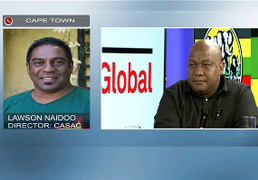Mandela’s death: no precedent for the president
by Michael Bleby
2013-12-06 00:34:37.0
THE death of Nelson Mandela poses a protocol challenge. No former president has been buried since the advent of democracy in 1994 and planners in the Presidency will be conducting Mandela’s funeral and associated activities without the benefit of experience. There is no precedent.
All former heads of state, including those of the former apartheid regime, are entitled to a state funeral with a lying-in-state of the body and full military honours. However, the families of the only former presidents to have died since 1994, PW Botha in October 2006 and Marais Viljoen in January 2007, declined to do so.
Botha’s family said it was his own wish not to have a state funeral. Nonetheless, upon declaring the news, then president Thabo Mbeki ordered flags at all official government buildings to be flown at half-mast until his burial. Books of condolence were opened at the Union Buildings in Pretoria and Tuynhuys in Cape Town and both Mbeki and FW de Klerk attended the funeral service at the Dutch Reformed Mother Church in George. Mbeki did not speak at the funeral, at which Botha’s brown coffin was not draped in any official regalia.
Viljoen had some state involvement — then deputy president Phumzile Mlambo-Ngcuka represented the government at the Pretoria funeral service at Aasvoëlkop Dutch Reformed Church. The South African National Defence Force’s ceremonial guard presented arms as the bereaved family moved past the Waterkloof air force base and his body was flown by military aircraft to the Bloemspruit air force base in Bloemfontein. The burial at Bloemfontein’s Heroes’ Acre was a private family ceremony. Mlambo-Ngcuka also attended the funeral of former state vice-president Alwyn Schlebusch at Kroonstad North NG Church in January 2008.
The funeral of Mandela will be a different affair altogether. While official funerals were given to a number of ANC and anti-apartheid leaders over the years — including OR Tambo in May 1993, Steve Tshwete in May 2002, Walter Sisulu in May 2003, Dullah Omar in March 2003 (on the day of his death, in accordance with Muslim tradition) and Beyers Naude in September 2004 — the closest model to the funeral of Mandela, in terms of numbers of people who will attend, is that of former South African Communist Party leader Chris Hani, who was assassinated in April 1993.
Many feared Hani’s murder would tip a tense, pre-election South Africa into chaos. The South African Human Rights Commission said at least 26 people were killed in post-death violence between the date of his murder and burial. The United Nations secretary-general appealed for calm. The outpouring of grief was great. More than 100,000 people paid their respects to his body as it lay in state at FNB Stadium on the day before his funeral. The National Party government did not send a representative to the funeral, but an estimated 90,000 people attended the ceremony on April 19 1993. The funeral was filled with fiery speeches and a 21-gun salute.
The funeral of OR Tambo, a couple of weeks later, was a calmer affair. After Tambo’s death from natural causes, just five days after Hani’s funeral, his body lay in state for a day at St Mary’s cathedral in central Johannesburg. Priest Trevor Huddleston conducted the funeral service, also at FNB Stadium, but the number of attendees was a third of Hani’s number. The presence of foreign dignitaries — including an 18-strong US official delegation — gave the ceremony the "air of a state burial", newspapers at the time reported.
When it comes to the division between party and state in the conduct of Mandela’s funeral, a clue may come from that of former safety and security minister Steve Tshwete in May 2002. His coffin, draped in an African National Congress flag, was carried into Eastern Cape stadium by members of the Cabinet. After justice minister Penuell Maduna, foreign affairs minister Nkosazana Dlamini-Zuma and defence minister Mosiuoa Lekota folded the party flag draping Tshwete’s coffin and presented it to his widow, the state service began. South African National Defence Force members draped a national flag over the coffin and then police commissioner Jackie Selebi led an official salute by police officers.
Mandela’s funeral will, however, be a different affair altogether. All South African embassies around the world will open books of condolence. All provinces will organise memorial services, apart from Gauteng, where the main memorial service is likely to be held at Soccer City near Soweto and where Mandela’s body will lie in state at the Union Buildings in Pretoria. It is also expected that he will be buried in his home village in Qunu in the Eastern Cape, where a funeral service will be conducted.
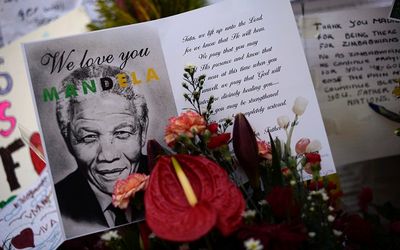
Cards and flowers left outside the Medi-Clinic Heart Hospital, where the ailing former South African president Nelson Mandela was treated, earlier this year. Picture: REUTERS
THE death of Nelson Mandela poses a protocol challenge. No former president has been buried since the advent of democracy in 1994 and planners in the Presidency will be conducting Mandela’s funeral and associated activities without the benefit of experience. There is no precedent.
All former heads of state, including those of the former apartheid regime, are entitled to a state funeral with a lying-in-state of the body and full military honours. However, the families of the only former presidents to have died since 1994, PW Botha in October 2006 and Marais Viljoen in January 2007, declined to do so.
Botha’s family said it was his own wish not to have a state funeral. Nonetheless, upon declaring the news, then president Thabo Mbeki ordered flags at all official government buildings to be flown at half-mast until his burial. Books of condolence were opened at the Union Buildings in Pretoria and Tuynhuys in Cape Town and both Mbeki and FW de Klerk attended the funeral service at the Dutch Reformed Mother Church in George. Mbeki did not speak at the funeral, at which Botha’s brown coffin was not draped in any official regalia.
Viljoen had some state involvement — then deputy president Phumzile Mlambo-Ngcuka represented the government at the Pretoria funeral service at Aasvoëlkop Dutch Reformed Church. The South African National Defence Force’s ceremonial guard presented arms as the bereaved family moved past the Waterkloof air force base and his body was flown by military aircraft to the Bloemspruit air force base in Bloemfontein. The burial at Bloemfontein’s Heroes’ Acre was a private family ceremony. Mlambo-Ngcuka also attended the funeral of former state vice-president Alwyn Schlebusch at Kroonstad North NG Church in January 2008.
The funeral of Mandela will be a different affair altogether. While official funerals were given to a number of ANC and anti-apartheid leaders over the years — including OR Tambo in May 1993, Steve Tshwete in May 2002, Walter Sisulu in May 2003, Dullah Omar in March 2003 (on the day of his death, in accordance with Muslim tradition) and Beyers Naude in September 2004 — the closest model to the funeral of Mandela, in terms of numbers of people who will attend, is that of former South African Communist Party leader Chris Hani, who was assassinated in April 1993.
Many feared Hani’s murder would tip a tense, pre-election South Africa into chaos. The South African Human Rights Commission said at least 26 people were killed in post-death violence between the date of his murder and burial. The United Nations secretary-general appealed for calm. The outpouring of grief was great. More than 100,000 people paid their respects to his body as it lay in state at FNB Stadium on the day before his funeral. The National Party government did not send a representative to the funeral, but an estimated 90,000 people attended the ceremony on April 19 1993. The funeral was filled with fiery speeches and a 21-gun salute.
The funeral of OR Tambo, a couple of weeks later, was a calmer affair. After Tambo’s death from natural causes, just five days after Hani’s funeral, his body lay in state for a day at St Mary’s cathedral in central Johannesburg. Priest Trevor Huddleston conducted the funeral service, also at FNB Stadium, but the number of attendees was a third of Hani’s number. The presence of foreign dignitaries — including an 18-strong US official delegation — gave the ceremony the "air of a state burial", newspapers at the time reported.
When it comes to the division between party and state in the conduct of Mandela’s funeral, a clue may come from that of former safety and security minister Steve Tshwete in May 2002. His coffin, draped in an African National Congress flag, was carried into Eastern Cape stadium by members of the Cabinet. After justice minister Penuell Maduna, foreign affairs minister Nkosazana Dlamini-Zuma and defence minister Mosiuoa Lekota folded the party flag draping Tshwete’s coffin and presented it to his widow, the state service began. South African National Defence Force members draped a national flag over the coffin and then police commissioner Jackie Selebi led an official salute by police officers.
Mandela’s funeral will, however, be a different affair altogether. All South African embassies around the world will open books of condolence. All provinces will organise memorial services, apart from Gauteng, where the main memorial service is likely to be held at Soccer City near Soweto and where Mandela’s body will lie in state at the Union Buildings in Pretoria. It is also expected that he will be buried in his home village in Qunu in the Eastern Cape, where a funeral service will be conducted.


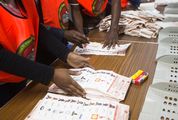
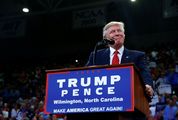



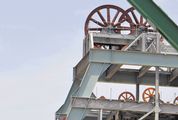

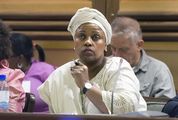
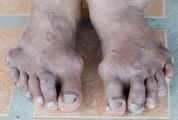
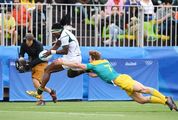
 News and views on the death, and life, of former president Nelson Mandela, with
tributes and photographs
News and views on the death, and life, of former president Nelson Mandela, with
tributes and photographs





